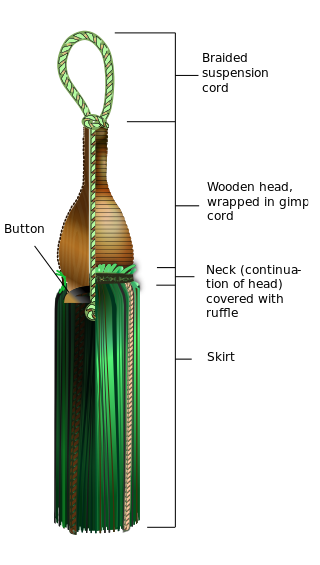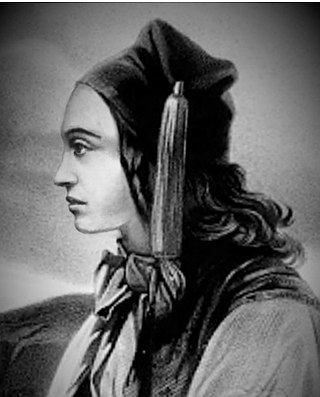Related Research Articles

The hilt is the handle of a knife, dagger, sword, or bayonet, consisting of a guard, grip and pommel. The guard may contain a crossguard or quillons. A tassel or sword knot may be attached to the guard or pommel.

A tassel is a finishing feature in fabric and clothing decoration. It is a universal ornament that is seen in varying versions in many cultures around the globe.

The square academic cap, graduate cap, cap, mortarboard or Oxford cap is an item of academic dress consisting of a horizontal square board fixed upon a skull-cap, with a tassel attached to the centre. In the UK and the US, it is commonly referred to informally in conjunction with an academic gown as a "cap and gown". It is also sometimes termed a square, trencher, or corner-cap. The adjective academical is also used.

A haplotype is a group of alleles in an organism that are inherited together from a single parent.
In population genetics, linkage disequilibrium (LD) is the non-random association of alleles at different loci in a given population. Loci are said to be in linkage disequilibrium when the frequency of association of their different alleles is higher or lower than expected if the loci were independent and associated randomly.

A galero is a broad-brimmed hat with tasselated strings which was worn by clergy in the Catholic Church. Over the centuries, the red galero was restricted to use by individual cardinals while such other colors as black, green and violet were reserved to clergy of other ranks and styles.
The International HapMap Project was an organization that aimed to develop a haplotype map (HapMap) of the human genome, to describe the common patterns of human genetic variation. HapMap is used to find genetic variants affecting health, disease and responses to drugs and environmental factors. The information produced by the project is made freely available for research.

The sporran, a traditional part of male Scottish Highland dress, is a pouch that performs the same function as pockets on the pocketless kilt. Made of leather or fur, the ornamentation of the sporran is chosen to complement the formality of dress worn with it. The sporran is worn on a leather strap or chain, conventionally positioned in front of the groin of the wearer.

The British Rail Class 413 units were formed from 1982 by permanently coupling two Class 414 2-HAP units together. There were two sub-classes of units: class 413/2, units 3201–3213, converted in 1982 from phase 1 2 HAP units 6001-6049. These units were formed DTCsoL - MBSO - MBSO - DTCsoL, with the former driving equipment of the DMBSO decommissioned, giving the new designation; and class 413/3, converted from the later phase 2 build units 6050–6173, units 3301–3311 and 3321–3325 (formed 1991, with the DMBSO outermost giving the formation, DMBSO - TCsoL - TCsoL - DMBSO. The centre vehicles again had their driving equipment decommissioned.

Imputed righteousness is a concept in Christian theology proposing that the "righteousness of Christ...is imputed to [believers]—that is, treated as if it were theirs through faith." It is on the basis of Jesus' righteousness that God accepts humans. This acceptance is also referred to as justification.
Ashtar is the name given to an extraterrestrial being or group of beings that a number of people claim to have channeled. UFO contactee George Van Tassel was the first to claim to receive an Ashtar message in 1952. Since then, experiences involving Ashtar have been claimed to occur in many contexts. The Ashtar movement is studied by academics as a prominent form of UFO religion.

The tasselled wobbegong is a species of carpet shark in the family Orectolobidae and the only member of its genus. It inhabits shallow coral reefs off northern Australia, New Guinea, and adjacent islands. Reaching 1.8 m (5.9 ft) in length, this species has a broad and flattened body and head. Its most distinctive trait is a fringe of branching dermal flaps around its head, which extends onto its chin. The fringe, along with its complex color pattern of small blotches and reticulations, enable it to camouflage itself against the reef environment.

Passementerie or passementarie is the art of making elaborate trimmings or edgings of applied braid, gold or silver cord, embroidery, colored silk, or beads for clothing or furnishings.

The Icelandic tail-cap or skotthúfa is a typical part of the Icelandic national costume. Originally it was only worn by men, but starting in the 18th century women started to wear it along with the peysa, a men's jacket with a single row of buttons creating the proto-peysuföt. Later it was adopted for the bodice-dress.

The Hôtel Tassel is a historic town house in Brussels, Belgium. It was designed by Victor Horta for the scientist and professor Emile Tassel, and built between 1892 and 1893, in Art Nouveau style. It is generally considered one of the first buildings in that style, along with the Hankar House by Paul Hankar, built at the same time, because of its highly innovative plan and its ground-breaking use of materials and decoration. It is located at 6, rue Paul-Emile Janson/Paul-Emile Jansonstraat, a few steps from the Avenue Louise/Louizalaan.

An ayam (아얌) is a Korean traditional winter cap mostly worn by women in the Joseon period for protection against the cold. It is also called aegeom which literally means "covering a forehead" in Korean. There is a historical record which mentions that officials in a low class called iseo wore ayam in the early Joseon period, so it was a unisex cap. However, it is not clear whether the shape at that time was identical to that of the later period. During the late Joseon period, an ayam was usually worn by female commoners. Especially in the western part of Korea, kisaeng commonly wore an ayam, and they were also worn as a simple formal headgear.

William Happer is an American physicist who has specialized in the study of atomic physics, optics and spectroscopy. He is the Cyrus Fogg Brackett Professor of Physics, emeritus, at Princeton University, and a long-term member of the JASON advisory group, where he pioneered the development of adaptive optics. From 1991 to 1993, Happer served as director of the Department of Energy's Office of Science as part of the George H.W. Bush administration. He was dismissed from the Department of Energy in 1993 by the Clinton Administration after disagreements on the ozone hole.

Infused righteousness forms the basis for the doctrine of justification in the Roman Catholic Church and is rooted in the theology of Thomas Aquinas and Augustine of Hippo. The doctrine states that through keeping the commands of Christ, regular confession and penance, and receiving the sacraments, God's grace/righteousness is "infused" in believers more and more over time, and their own "righteousness in the flesh" becomes subsumed into God's righteousness.
Norigae is a typical, traditional Korean accessory used in Hanbok, which can be hung on goreum of a woman's jeogori or on her chima. The norigae functions as a decorative pendant and is both a good-luck charm hoped to bring something such as eternal youth, wealth or many sons, as well as a fashion accessory. Usually, the norigae from the parents' or in-laws' home was passed down to descendants.
Imputation in genetics refers to the statistical inference of unobserved genotypes. It is achieved by using known haplotypes in a population, for instance from the HapMap or the 1000 Genomes Project in humans, thereby allowing to test for association between a trait of interest and experimentally untyped genetic variants, but whose genotypes have been statistically inferred ("imputed"). Genotype imputation is usually performed on SNPs, the most common kind of genetic variation.